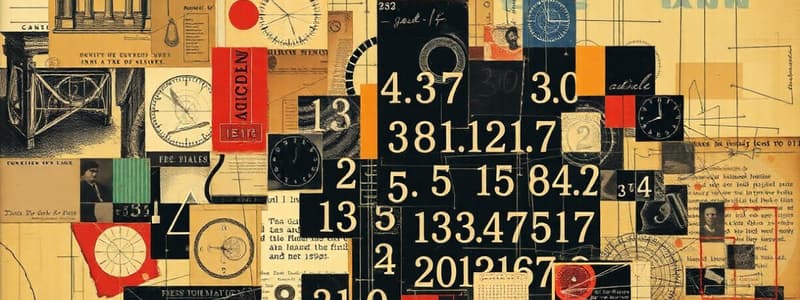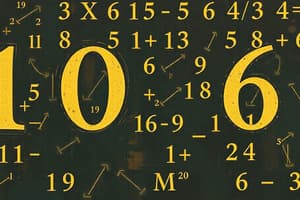Podcast
Questions and Answers
Which measure of central tendency represents the value that appears most frequently in a dataset?
Which measure of central tendency represents the value that appears most frequently in a dataset?
- Mean
- Median
- Mode (correct)
- Variance
What is the primary purpose of statistical inference?
What is the primary purpose of statistical inference?
- Calculating the mean of a dataset
- Using sample data to make conclusions about a population (correct)
- Describing the shape of a probability distribution
- Determining the variance of a set of values
In probability theory, what does a probability distribution represent?
In probability theory, what does a probability distribution represent?
- A method for counting outcomes
- A formula for calculating the standard deviation
- The mean of a dataset
- The likelihood of different outcomes of a random experiment (correct)
Which concept in discrete mathematics focuses on the structure of relationships between objects?
Which concept in discrete mathematics focuses on the structure of relationships between objects?
Which of the following best describes mathematical modeling?
Which of the following best describes mathematical modeling?
Which number is classified as a natural number?
Which number is classified as a natural number?
What defines rational numbers?
What defines rational numbers?
What type of equation represents a straight line?
What type of equation represents a straight line?
What is the inverse operation of exponentiation?
What is the inverse operation of exponentiation?
Which of the following is NOT a basic shape in geometry?
Which of the following is NOT a basic shape in geometry?
What is the purpose of differentiation in calculus?
What is the purpose of differentiation in calculus?
Which of the following accurately describes imaginary numbers?
Which of the following accurately describes imaginary numbers?
What do integrals represent in calculus?
What do integrals represent in calculus?
Flashcards
Natural Numbers
Natural Numbers
Positive whole numbers (1, 2, 3, and so on).
Integers
Integers
Whole numbers and their opposites (e.g., -3, -2, -1, 0, 1, 2, 3).
Rational Numbers
Rational Numbers
Numbers that can be written as a fraction of two integers.
Variables
Variables
Signup and view all the flashcards
Equations
Equations
Signup and view all the flashcards
Differentiation
Differentiation
Signup and view all the flashcards
Integration
Integration
Signup and view all the flashcards
Complex Numbers
Complex Numbers
Signup and view all the flashcards
Mean
Mean
Signup and view all the flashcards
Probability
Probability
Signup and view all the flashcards
Sets
Sets
Signup and view all the flashcards
Functions
Functions
Signup and view all the flashcards
Algorithms
Algorithms
Signup and view all the flashcards
Study Notes
Preliminaries
- Mathematics is a broad field encompassing various concepts and applications.
- It deals with logic, quantity, space, and change.
- It serves as a foundation for many scientific and technological disciplines.
Number Systems
- Natural numbers (N): Positive integers (1, 2, 3, ...).
- Whole numbers (W): Non-negative integers (0, 1, 2, 3, ...).
- Integers (Z): Whole numbers and their negative counterparts (-3, -2, -1, 0, 1, 2, 3, ...).
- Rational numbers (Q): Numbers that can be expressed as a fraction p/q, where p and q are integers and q is not zero.
- Irrational numbers: Numbers that cannot be expressed as a fraction of two integers.
- Real numbers (R): The set of rational and irrational numbers.
- Imaginary numbers (i): Numbers based on the square root of -1.
- Complex numbers (C): Numbers of the form a + bi, where a and b are real numbers and i is the imaginary unit.
Arithmetic Operations
- Addition (+): Combining quantities.
- Subtraction (-): Finding the difference between quantities.
- Multiplication (× or *): Repeated addition.
- Division (/ or ÷): Repeated subtraction.
- Exponentiation (^): Repeated multiplication.
- Roots: Inverse of exponentiation.
Algebra
- Variables: Symbols representing unknown quantities.
- Equations: Statements of equality between two expressions.
- Inequalities: Statements of inequality.
- Polynomials: Expressions involving variables and coefficients.
- Linear equations: Equations representing straight lines.
- Quadratic equations: Equations involving a variable raised to the second power.
- Factoring: Decomposing expressions into simpler factors.
- Solving equations: Finding the values of variables that satisfy the equation.
Geometry
- Basic shapes: Points, lines, angles, triangles, polygons, circles, etc.
- Measurements: Length, area, volume, perimeter, etc.
- Geometric theorems: Statements proven to be true.
- Constructions: Drawing geometric figures using tools like a compass and straightedge.
- Transformations: Moving and resizing figures.
Calculus
- Differentiation: Finding the rate of change of a function.
- Integration: Finding the area under a curve.
- Limits: Evaluating the behavior of a function as its input approaches a certain value.
- Derivatives: Functions representing instantaneous rate of change.
- Integrals: Functions representing cumulative change.
Statistics and Probability
- Data collection and analysis using graphs, tables, and calculations.
- Measures of central tendency (mean, median, mode).
- Measures of dispersion (range, variance, standard deviation).
- Probability: The likelihood of an event occurring.
- Probability distributions: Models describing the possible outcomes of random experiments.
- Statistical inference: Using sample data to draw conclusions about a larger population.
Discrete Mathematics
- Logic: Rules and techniques for reasoning.
- Sets: Collections of objects.
- Relations: Connections between objects.
- Functions: Mathematical correspondences.
- Graphs: Networks of nodes and edges.
- Counting techniques: Methods for determining the number of possible outcomes.
- Algorithms: Step-by-step procedures to solve problems.
Other Important Concepts
- Mathematical proofs: Demonstrations of mathematical statements.
- Mathematical modeling: Constructing mathematical representations of real-world phenomena.
- Applications of mathematics: Use of mathematics in various fields.
- Problem-solving: Applying mathematical techniques to solve practical problems.
- Mathematical reasoning and thinking involving different levels of abstraction and complexity.
Studying That Suits You
Use AI to generate personalized quizzes and flashcards to suit your learning preferences.




